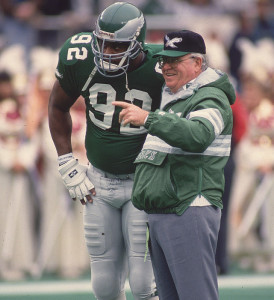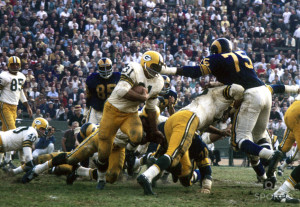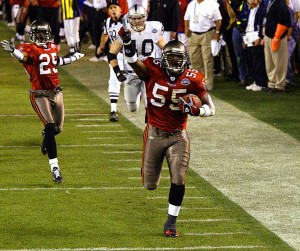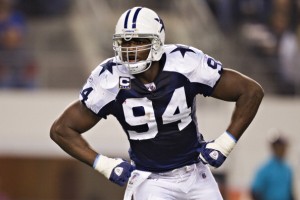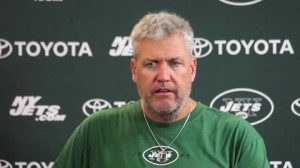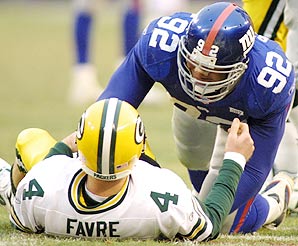Ten years ago, the teams with three of the four best defenses in football missed the playoffs. The Buffalo Bills ranked 1st in Adjusted Net Yards per Attempt allowed and 2nd in Adjusted Yards per Carry allowed. That year, Sam Adams, Takeo Spikes, Terrence McGee, and Nate Clements made the Pro Bowl, while Aaron Schobel had 8 sacks and London Fletcher was London Fletcher but younger. The team ranked 1st in DVOA by a good margin, but finished 9-7, narrowly missing the playoffs.
That year, Baltimore ranked 4th in ANY/A allowed, 3rd in AYPC allowed, and 2nd in DVOA. The Ravens weren’t quite as good on defense as the ’00 or ’06 iterations, but still had Terrell Suggs, Ray Lewis, Adalius Thomas, Chris McAlister, and Ed Reed (not to mention a 37-year-old Deion Sanders). Of course, this was the Ravens team that was one of the most one-sided team in NFL history. Baltimore also finished 9-7 in a year where six AFC teams won double-digit games.
Over in the NFC, Washington’s defense ranked 1st in Adjusted YPC and 3rd in ANY/A in Joe Gibbs’ first season back in D.C. Marcus Washington was the team’s only Pro Bowler, but the defense featured a rookie Sean Taylor, Ryan Clark, Shawn Springs, Antonio Pierce, and Cornelius Griffin. Despite ranking 4th in defensive DVOA, the team won just six games.
So why today are we looking at these three teams, nearly ten years later? It’s not to remind you that Drew Bledsoe, Kyle Boller, and Mark Brunell failed to guide those teams to the playoffs. As it turns out, these are the last three teams to finish in the top five in both ANY/A allowed and AYPC allowed and still miss the playoffs. In fact, since 1970, just nine other teams have managed to pull off that feat.
- In 2002, Miami ranked 5th in both ANY/A and AYPC allowed, while the Panthers ranked 4th in both categories. Carolina was a year away from a Super Bowl appearance, while the Dolphins were nearing the end of their Jason Taylor–Zach Thomas–Sam Madison run.
- In 1999, a year before The Year, the Ravens ranked 2nd in both metrics but finished just 8-8.
- In 1998, the Raiders and Chargers had great defenses, but neither could challenge (or slow down) the Broncos. Behind Norman Hand, John Parrella, Kurt Gouveia, Junior Seau, and Rodney Harrison, the Chargers fielded one of the greatest rush defenses of all time; unfortunately, they also fielded Ryan Leaf and Craig Whelihan at quarterback. The Raiders had a pair of blue chip 22-year-olds in Darrell Russell and Charles Woodson, but first-year head coach Jon Gruden couldn’t get the offense to the playoffs.
- You know all about the 1991 Eagles, so of course they are on this list.
- The 1987 Giants, a year after winning the Super Bowl, still produced a Super Bowl caliber defense behind Lawrence Taylor, Carl Banks, Pepper Johnson, and Harry Carson, but the team’s offensive line (3rd most sacks allowed, 2nd worst YPC average) torpedoed the offense.
- In 1978, a year before nearly carrying the team to the Super Bowl, Lee Roy Selmon and Dave Pear helped Tampa Bay rank 1st in AYPC allowed and 3rd in ANY/A allowed. But a miserable offense led to a losing record in the franchise’s third season.
- The 1974 Packers ranked 5th in both categories. The defense sent Ted Hendricks, Willie Buchanon, and Ken Ellis to the Pro Bowl, but if you think this is just a thinly-veiled reason to bring up John Hadl, you are a regular reader of this blog.
Since 2004, six teams have ranked 1st or 2nd in AYPC allowed but missed the playoffs. Two of those seasons occurred last year, with the Jets and Cardinals, respectively. The 2006 and 2007 Vikings also join that list, along with the 2007 Ravens (a year after a magnificent season) and the 2010 49ers (a year before a magnificent season).
Having a dominant pass defense is even more likely to send a team to the playoffs. Since 2004, only one team — the 2012 Bears — ranked 1st in ANY/A allowed but missed the playoffs. The 2009 Bills are the only team to rank 2nd in ANY/A allowed and miss the playoffs, while the 2013 Bills, 2010 Chargers, and ’05 Jets are the only teams since ’04 to rank 3rd in ANY/A allowed and still fail to make it to January.
Too Long; Didn’t Read
- The 2004 season was kind of crazy.
- Since 2002, 24 teams have ranked in the top five in both pass defense and rush defense; five of those teams missed the playoffs, although the last 16 teams pull off this feat have made the postseason.
- Of the 36 teams to rank in the top 3 in Adjusted Yards per Carry allowed since 2002, only 19 of those teams made the playoffs. Although it’s worth noting that eight of the 17 teams to miss the playoffs out of this group ranked 20th or worse in ANY/A allowed.
- 28 of the 36 teams to rank in the top 3 in ANY/A allowed made the playoffs.


